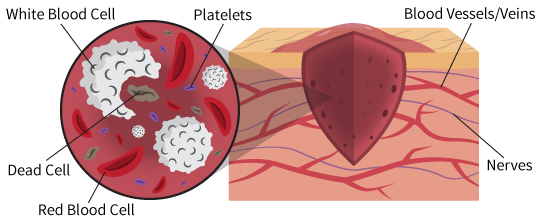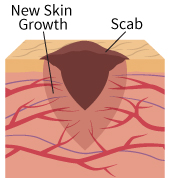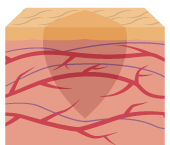show/hide words to know
How Your Body Repairs Cuts
After you get a paper cut, it's important that your body closes the cut (the wound) so you avoid getting an infection. There are three stages of wound healing to repair the cut. The stages are kind of like what you might go through if you tried to build a house.
First, the site has to be prepped and planning begins. Special cells called neutrophils are called in to help. They attract other immune cells and help trap invaders. During this inflammatory phase, your body stops blood loss by clotting the blood and reducing blood flow. Lots of "supervisors" like proteins, blood cells, and antibodies are sent to the site. Macrophages are a critical part of this wound healing team. They come to clean up the site before the building can start. They eat the dead skin cells and other waste around the area.

Once the wound is free of germs, the waste is cleaned up, and the skin growth started, the macrophages and neutrophils start to leave. It's important they leave because having inflammation for long periods of time can cause serious problems.

Second, your body starts rebuilding the lost tissue and replacing broken blood vessels with fresh ones. At the house, this would be like the work of plumbers and framers. Cells called fibroblasts provide the building materials, to repair the tissue.
New vessels are added that can help more blood reach the wound, and special cells start adding substances in preparation for more cells to be added. Cells start gathering at the edges of the wound and more and more are added until they reach the cells gathering at the other side of the wound.
This teamwork makes the bright red, bumpy skin you see inside your cut at the beginning stages of healing. The red color is from all the blood vessels that were build to heal the injury. The bumpiness is from the fibroblasts slowly rebuilding the area.

In the final stage of wound healing, a lot of remodeling occurs. Special proteins (or "tools") that were needed for early stages of healing are replaced with tools used for remodeling. A tissue called collagen is important for strength, durability, and scarring of your new skin.
These are the final touches put on the house to make sure everything is in the right place. The electrician is involved as nerve endings that were damaged in the injury need to be rebuilt. After all the work is done, you have fully remodeled skin!
Facial scar by LauraLewis23 via Wikimedia Commons.
View Citation
Bibliographic details:
- Article: Wound Healing
- Author(s): Kimberly Repp
- Publisher: Arizona State University School of Life Sciences Ask A Biologist
- Site name: ASU - Ask A Biologist
- Date published: February 21, 2015
- Date accessed: April 17, 2024
- Link: https://askabiologist.asu.edu/wound-healing
APA Style
Kimberly Repp. (2015, February 21). Wound Healing. ASU - Ask A Biologist. Retrieved April 17, 2024 from https://askabiologist.asu.edu/wound-healing
Chicago Manual of Style
Kimberly Repp. "Wound Healing". ASU - Ask A Biologist. 21 February, 2015. https://askabiologist.asu.edu/wound-healing
Kimberly Repp. "Wound Healing". ASU - Ask A Biologist. 21 Feb 2015. ASU - Ask A Biologist, Web. 17 Apr 2024. https://askabiologist.asu.edu/wound-healing
MLA 2017 Style

The body still has some remodeling to do before the scar from this cut fades.
If you like this story, check out our Viral Attack comic book.
Be Part of
Ask A Biologist
By volunteering, or simply sending us feedback on the site. Scientists, teachers, writers, illustrators, and translators are all important to the program. If you are interested in helping with the website we have a Volunteers page to get the process started.







